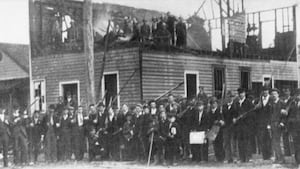It’s better to have a war of words than a real war. If you’re looking for a silver lining to our current political situation, the political combat between our elected leaders has been confined to mean tweets and name-calling, not gunplay and death.
Consider a recent incident that barely even registered: When asked about Minority Leader Kevin McCarthy’s criticism of the Capitol physician’s mask mandate, House Speaker Nancy Pelosi referred to her Republican colleague as “a moron.” Today, “spats” like that, or Donald Trump insulting Ted Cruz’s wife and father, barely elicit a yawn.
But there was a time when they drew blood, literally. “Between 1830 and 1860,” writes Joanne B. Freeman in The Field of Blood: Violence in Congress and the Road to Civil War, “there were more than 70 violent incidents between congressmen in the House and Senate chambers or on nearby streets and dueling grounds, most of them long forgotten.”
In one instance, a Louisiana congressman named John Dawson, who routinely carried a bowie knife and a pistol, threatened to cut another congressman’s throat “from ear to ear.” In another, Sen. Henry S. Foote pulled a gun on Sen. Thomas Hart Benton on the Senate floor after Vice President Millard Fillmore—who’d delivered a speech just two weeks earlier lamenting how “a slight attack, or even insinuation, of a personal character, often provokes a more severe retort, which brings out a more disorderly reply, each Senator feeling a justification in the previous aggression”— called Benton to order.
That provoked a heated argument where Sen. Henry Clay accused Fillmore of violating the power and dignity of the Senate. In the course of that, Benton, a very big man, charged at Foote, a “diminutive one” according to the account on the Senate’s website, who then pulled out a gun. “As pandemonium swept the chamber, Benton bellowed, ‘I have no pistols! Let him fire! Stand out of the way and let the assassin fire!’”
One of the most famous acts of political violence came in a 1838 duel between congressmen Jonathan Cilley of Maine (a Democrat) and William Graves of Kentucky (a Whig), in which Graves killed Cilley for less cause than Trump gave Cruz. Cilley had insinuated that a newspaper editor named James Watson Webb was corrupt, and Webb asked Graves to deliver a note asking for an apology. Cilley refused to accept the letter, which was taken by Graves to be a personal slight. That’s all it took for Graves to shoot down Cilley in a duel with two other House members there serving as their seconds.
Even back then, there was a fight about the fight. The age-old script said martyrdom was a powerful political cudgel that partisan newspapers were quick to exploit. “Given that the dead man was a Democrat,” Freeman writes, “Whig papers were at a disadvantage, but they took their share of swings. Many chided the Democrats for using a ‘bloody tragedy... for electioneering purposes,’ then turned around and did the same…” How did they seek to recast the tragedy? By “claiming that Cilley’s friends—a gang of assassin Democrats—had sacrificed Cilley to get at Webb.” Sound familiar?
Predictably, there was great debate over whether to conduct a formal investigation, with the arguments against eerily mirroring those that modern-day Republicans cited to defeat a bipartisan 9/11-style commission about the events of Jan. 6. “Whigs roared that emotions were too heated for a fair investigation,” Freeman writes. Southern Whigs warned that “it was bound to cause more bloodshed.” There was also a sense that people serving on the commission would be inviting trouble, with one congressman “advising its members to arm themselves.”
A committee was established, but, instead of establishing a shared set of facts, it produced “three different reports.” Afterward, Freeman tells us, “Virtually every participant [in the duel] won reelection the following session.”
Freeman’s book owes much to Benjamin Brown French, a congressional clerk who kept a meticulous journal documenting much of the violence of his day. And Freeman writes that while French found something noble in the duel, he “was less philosophical about clashes that stopped the wheels of government. Outbreaks and pandemonium that prevented sessions of Congress from formally opening or closing almost always sent him into a frightened tailspin of doom.”
She continues, “Maybe this time there would be no compromise. Maybe this time the government would break down.”
Before that could happen, there was another famous “surrogate” battle in 1856. In this instance, South Carolina Rep. Preston Brooks brutally beat abolitionist Sen. Charles Sumner of Massachusetts in the Senate chamber, nearly killing him, after Sumner had delivered an anti-slavery speech that also personally mocked one of Brooks’ slaveholding relatives. A select committee investigated.
Brooks resigned but was immediately re-elected, which goes to show that then, as now, you couldn’t count on the public to police this sort of behavior. They were often proud of the pols who were, after all, their representatives in all this.
All this violence played out against the backdrop of escalating tensions over the issue of slavery that eventually would cause the Civil War, with the caning of Sumner representing “the breakdown of reasoned discourse” as the nation “tumbled onward toward the catastrophe of civil war.”
As dark as things may seem now, perhaps some comfort and clarity can be found by realizing that the capitol has seen bloody days before, and considering that we have a chance to learn from our history instead of merely echoing it.









